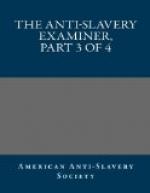This case is given to the reader at length, in order fully to show, that in a community where the law sanctions the commission of every species of outrage upon one class of citizens, it fosters passions which will paralyze its power to protect the other classes. Look at the facts developed in this case, as exhibiting the state of society among slaveholders. 1st. That the members of the legislature are in the habit of wearing bowie knives. Wilson’s knife was 10 or 11 inches long.[42] 2d. The murderer, Wilson, was a man of wealth, president of the bank at the capital of the state, a high military officer, and had, for many years, been Speaker of the House of Representatives, as appears from a previous statement in the Arkansas Gazette. 3d. The murder was committed in open day, before all the members of the House, and many spectators, not one of whom seems to have made the least attempt to intercept Wilson, as he advanced upon Anthony with his knife drawn, but “made way for him,” as is stated in another account. 4th. Though the murder was committed in the state-house, at the capital of the state, days passed before the civil authorities moved in the matter; and they did not finally do it, until the relations of the murdered man demanded a warrant for the apprehension of the murderer. Even then, several days elapsed before he was brought before an examining court. When his trial came on, he drove to it in state, drew up before the door with “his coach and four,” alighted, and strided into court like a lord among his vassals; and there, though a clearer case of deliberate murder never reeked in the face of the sun, yet he was admitted to bail, the court absolutely refusing to hear an argument from the prosecuting attorney, showing that it was not a bailable case. 5th. The sheriff of Pulaski county, who had Wilson in custody, “never confined him a moment, but permitted him to go at large wholly unrestrained.” When transferred to Saline co. for trial, the sheriff of that county gave Wilson the same liberty, and he spent his time in parties of pleasure, fishing, hunting, and at houses of entertainment. 6th. Finally, to demonstrate to the world, that justice among slaveholders is consistent with itself; that authorizing man-stealing and patronising robbery, it will, of course, be the




